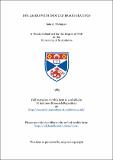Files in this item
Dye lasers with induced Bragg gratings
Item metadata
| dc.contributor.advisor | Maitland, Arthur | |
| dc.contributor.author | McIntyre, Iain A. | |
| dc.coverage.spatial | 200 p. | en_US |
| dc.date.accessioned | 2018-05-30T11:17:13Z | |
| dc.date.available | 2018-05-30T11:17:13Z | |
| dc.date.issued | 1985-07 | |
| dc.identifier.uri | https://hdl.handle.net/10023/13611 | |
| dc.description.abstract | This thesis describes a study of dye lasers which contain an induced Bragg gain grating within the active medium. These lasers fall into two categories - the distributed feedback dye laser and a novel configuration of a conventional cavity dye laser which is tuned by an induced grating (TING dye laser). After introducing the two different types of laser, a review of distributed feedback systems is made, discussing the coupled-wave theory of distributed feedback, including saturation and linewidth effects, and summarising the characteristics of previous experimental systems. This is followed by an analysis of the TING laser using multimode semi-classical laser theory. It is shown that the presence of the induced Bragg gain grating can have significant tuning and line-narrowing properties. In particular, it is shown that, if the induced grating fills a sufficiently large proportion of the cavity, the TING laser is able to oscillate on a single cavity mode in a stable fashion. Experiments on distributed feedback and TING lasers, both pumped by a frequency doubled, Q-switched Nd:YAG laser are then described. The distributed feedback system is completely characterised for efficiency, beam divergence, tuning range and amplified spontaneous emission. The linewidth of the radiation produced by this laser is investigated in particular detail. Contributions to the linewidth due to finite linewidth of pumping radiation, pump beam divergence and thermal effects in the dye are assessed experimentally and methods of minimising their influence explored. This last effect, due to refractive index change through solvent heating by the pump radiation, is shown to produce a frequency chirping in the output pulse from the dye laser. Careful choice of solvent enables this to be reduced. A further process limiting the ultimate linewidth achievable in dynamic distributed feedback dye lasers is identified. This is the changing dispersion, due to the changing saturated gain, in the active medium during the course of a pumping pulse. A model of this dispersion is used to predict correctly the temporal behaviour of the central laser frequency during a pulse. Having identified the processes limiting the ultimate linewidths achievable in conventional distributed feedback dye lasers, a novel technique for further line narrowing, that of incorporating frequency selective feedback, is explored. By using an etalon/mirror combination to feed radiation back into the dye laser at one end, linewidths have been reduced from around 0.3 A, the linewidth of the conventional DFB dye laser at reasonable pump powers, to 0.024 A with frequency selective feedback. Finally, a dual wavelength dye laser system is described in which the laser experiences feedback due to a conventional grazing incidence grating cavity and distributed feedback simultaneously. The two wavelengths obtained are independently tunable and this laser is characterised especially with respect to levels of amplified spontaneous emission and to gain competition between the two oscillating frequencies. | en_US |
| dc.language.iso | en | en_US |
| dc.publisher | University of St Andrews | |
| dc.subject.lcc | TK7871.3B8M5 | |
| dc.subject.lcsh | Lasers | |
| dc.title | Dye lasers with induced Bragg gratings | en_US |
| dc.type | Thesis | en_US |
| dc.type.qualificationlevel | Doctoral | en_US |
| dc.type.qualificationname | PhD Doctor of Philosophy | en_US |
| dc.publisher.institution | The University of St Andrews | en_US |
This item appears in the following Collection(s)
Items in the St Andrews Research Repository are protected by copyright, with all rights reserved, unless otherwise indicated.

